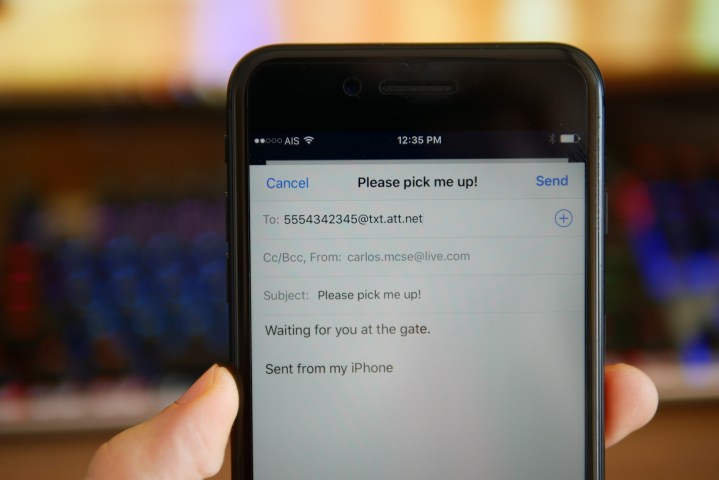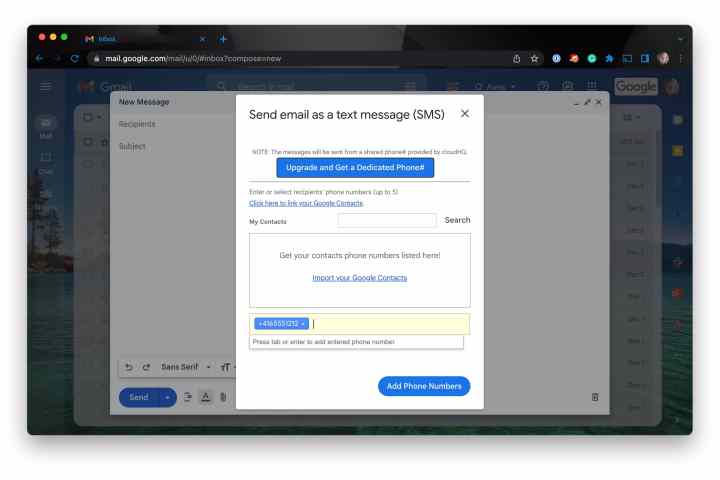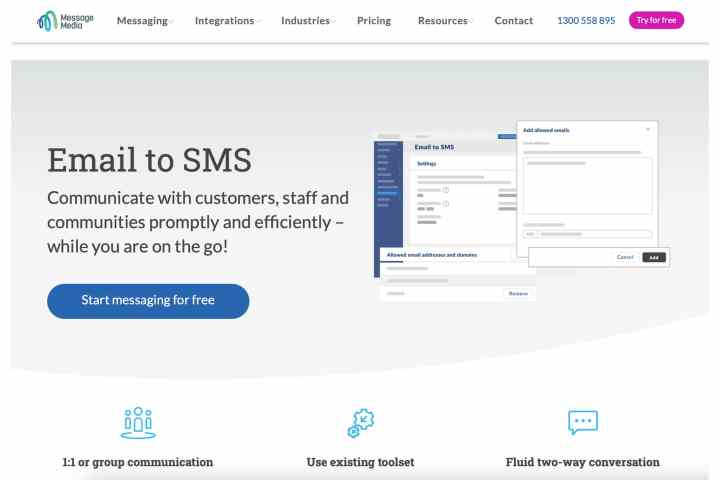With the many different messaging apps and services available to us online and on our mobile phones, sometimes it’s easy to forget that good old SMS still exists. It may not be the spiffiest messaging technology out there, but the one great thing about SMS is that it's universal; you may now know whether someone is on Facebook Messenger or WhatsApp, but if you know their phone number, it's nearly certain they'll be able to receive an SMS message. What's even better is that the message technology is pretty universal, meaning you can even send a text from email.
Well all know the person that never checks their email but constantly texts. If you’re ever in a pinch and without your phone for whatever reason, here is a guide on sending a text from email to these people.

How to send a text from an email
This guide will walk you through a few different methods to send a text from your email account. If you find yourself sending texts through email often, you might want to download a browser extension to make your life a little easier. We'll cover that in the next section; for now, though, the quickest way to get started sending SMS messages via email is just to use your normal mail app and the appropriate gateway addresses.
Step 1: Using the email client of your choice, compose your email. You can use either your smartphone or your computer to write it, and it doesn't matter whether you're using a traditional mail client like Outlook or Thunderbird or a webmail service like Gmail or Yahoo.
Step 2: Instead of entering an email address in the recipient box, insert the 10-digit phone number of the person you’re trying to reach, but don't press enter just yet.
Step 3: Instead, after entering the phone number, tack on the appropriate “@gateway” address on the end.
U.S. and Canadian carrier gateways for SMS emails
Whether you are going to send a text to an iPhone or Android phone from email, you need to know the recipients carrier. In other words, sending a text to an iPhone and Android phone could follow the same process, but sending a text to a Verizon phone from email will always differ from sending a text to T-Mobile from email.
Here's a list we've put together of some of the most common service providers in the United States and Canada and their corresponding gateway addresses. Keep in mind that if you’re trying to send a message that’s more than 160 characters long, it will typically be sent using the Multimedia Message Service (MMS) rather than being split into multiple SMS messages. If the person you’re messaging doesn’t have a messaging plan that includes MMS, then they'll either fail to receive the message or they may be charged an extra fee to open it.
Some carriers also offer specific email-to-MMS gateways. You can use these gateways to make sure longer messages get through. MMS can also send photos, albeit in very low resolutions.
| Carrier | SMS Gateway Domain | MMS Gateway Domain |
|---|---|---|
| AT&T | number@txt.att.net | number@mms.att.net |
| Boost Mobile | number@sms.myboostmobile.com | number@myboostmobile.com |
| Cricket Wireless | number@mms.cricketwireless.net | number@mms.cricketwireless.net |
| Google Project Fi | number@msg.fi.google.com | number@msg.fi.google.com |
| Republic Wireless | number@text.republicwireless.com | None |
| Sprint | number@messaging.sprintpcs.com | number@pm.sprint.com |
| Straight Talk | number@vtext.com | number@mypixmessages.com |
| T-Mobile | number@tmomail.net | number@tmomail.net |
| Ting | number@message.ting.com | None |
| Tracfone | Depends on underlying carrier | number@mmst5.tracfone.com |
| U.S. Cellular | number@email.uscc.net | number@mms.uscc.net |
| Verizon | number@vtext.com | number@vzwpix.com |
| Virgin Mobile | number@vmobl.com | number@vmpix.com |
| Bell Mobility | number@txt.bellmobility.com | |
| Rogers | number@pcs.rogers.com | |
| Fido | number@fido.ca | |
| Telus | number@msg.telus.com | |
| Koodo | number@msg.koodomobile.com | |
| Virgin Mobile | number@vmobile.ca |
One final thing to note is if you use Boost, Cricket Wireless, Republic Wireless, Straight Talk, Ting, or Tracfone — all of which are mobile virtual network operators (MVNO) — you may need to enter the gateway address belonging to either Sprint, T-Mobile, Verizon, or AT&T, rather than those in the above list, as they all piggyback on these major networks. The same applies to Canadian carriers Fido (Rogers), Koodo and Public Mobile (Telus), and Virgin Mobile (Bell Mobility), which can also use the gateways for their respective parent networks.

How to download an extension for faster texting
If you use Chrome as your browser and want to send SMS messages using your Gmail account on a regular basis, there's a handy extension called Send Your Email to SMS (text) that will save you quite a bit of time.
While there are quite a few more advanced features that require a paid subscription, the free version of the extension is surprisingly capable for basic texting. With the click of a button, you can enter a phone number to send an email to. And best of all, you don't need to worry about which carrier the recipient is on, as the CloudHQ service behind the extension will figure that out for you. You can also send longer, even formatted, rich-text email messages; the recipient will get a private link to view the full message in their web browser.
Note that only U.S. and Canadian numbers are supported on the free plan, and two-way communications are limited as the messages will be sent from a generic phone number. Upgrading to one of the paid tiers will get you a custom phone number, so your recipients can send replies to your inbox. The paid version even allows you to conduct marketing campaigns via SMS right from your Gmail inbox and set up more sophisticated automations for things like notifying you of important new emails via text.
For some more affordable automation features, Google Voice users can link Google Calendar with Gmail withthe If This Then That (IFTTT) smart management system. From here, you can set up IFTTT to schedule a text using Google Voice, which some may find a faster option than going through the whole process with email.

How to use web app services (business-friendly)
There are many online services and apps for sending texts via email, which may be more suitable for businesses. Message Media is one of our favorites since it makes the process very simple, and it supports SMS, RCS, MMS, Messenger, and even WhatsApp messages.
It has a useful feature where you can see your original message and the subsequent responses, so you can quickly track a conversation. It also allows you to text international phone numbers, and for an additional cost, you can use alpha tags for identifying senders, text-to-voice, dedicated numbers, and other handy extras.
You can try Message Media for free to see if it works for you, but you’ll need to sign up for a monthly subscription to continue use after the trial period.
Editors' Recommendations
- How to download shows and movies from Hulu for offline viewing
- How to play YouTube in the background on iPhone and Android
- Apple Music vs. Spotify: Which music streaming service is the best?
- How to fix the ‘iPhone Unavailable’ error on any iPhone
- How to reverse image search on Android or iPhone


